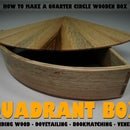Introduction: Make a Child's Country Chair
Why not have a go at making this country chair for a child! It will become a family heirloom without a doubt.
You'll need some hardwood:
- The end of a fairly wide plank of elm, oak, or similar will make the seat
- Eighteen inches of a half inch or three quarter inch thick and seven inch wide board for the seat back
- A log of apple, ash, beech, etc. to split for the legs and back sticks
(or some 1½" square battens instead)
A video of my build is available in three parts, and also includes an attempt to steam bend a seat back which didn't go so well!
I'm entered in the Design for Kids Challenge, so please vote if you like it.
Step 1: Starting the Seat
Draw in the seat shape. Using the child as a pattern for the inner, scooped area, is a good idea, but allow a little extra space for growth. Then add the raised area allowance of about two inches, into which the back sticks will go
Four leg holes should be marked in approximately three inches in from four corners
The leg holes are bored flaring out from the centre of the seat. The angle is up to you, but six to ten degrees seems to work well. This gives a wider base, and adds to stability
Holes for the six back sticks are bored in what will be the raised area around the scooped seat. They are also sloped, and create the fanned appearance you can see in the finished chair. Again, the exact angles are up to you, and I suggest you mock it up first to see what you like
I didn't use any power tools in my build, but there's no reason why you can't
Step 2: Shaping the Seat
Use an adz, gouge, and/or scorp (or anything else you can think of!) to scoop out the seat area to a comfortable shape. You may need to get a child in to gauge progress, but I found a snug fit for my bum was just about ideal for most children of five years or more
Saw out the outline of the seat, and clean up with spokeshave, etc.
Blend the scooped area into the front edge, and smooth all the surfaces
Step 3: Legs and Back Sticks
Split battens from the log to make the legs and back sticks
Rough out the shapes with a hatchet, before moving on to a draw knife and spokeshave
Complete the leg shaping by forming a round tenon to fit the leg holes in the seat, and the back stick shaping by forming round tenons at each end (one for the seat, and one for the seat back)
Once dry fitted, use a gauge to level the feet and the top of the back sticks
Step 4: Seat Back
With the seat inverted and standing on the back sticks, mark the tenon positions onto a piece of paper
Draw an outline for the seat back, which centres the mortise positions in it's width and creates a comfortable shape (I used a flexible drill shaft to lay out a smooth curve)
Saw out the seat back, and clean it up using a spokeshave
Bore the mortise holes for the back sticks
Step 5: Attaching Legs
With the legs dry fitted, mark for wedges which run across the grain of the seat
Saw a slot for each of the wedges in the leg tenons, and prepare some wedges to fit
Glue the legs in place, inserting glued wedges at the same time
Saw off as much excess of the tenons as possible, and flush them with the seat surface
Step 6: Fitting Seat Back and Sticks
With the seat, back sticks, and seat back dry fitted, mark for wedges on all tenons
Saw slots for all the wedges, and since these tenons are quite thin, drill a relief hole across the bottoms of the slots to prevent splitting
Assemble with glue, adding glued wedges at the same time
Flush off all wedges/tenon ends
Step 7: Apply Finish
Appropriate use of sharp hand tools should have left the chair smooth enough to apply a finish straight away, but difficult grain situations, etc may require some sanding. Don't omit this if it's needed, since the final result will suffer
I chose to apply an oil finish (Odie's oil), which I wiped dry after about forty minutes
The next day I buffed the life out of it, to achieve a lovely satin/semi-gloss finish
A second coat is recommended for better protection, and/or furniture wax can be applied
Step 8: Ready for a Kid - Even a Big One!
I hope you'll make your own chair, and look forward to seeing photo's in the comments
I'm entered in the Design for Kids Challenge, so please vote if you like it.
Thanks for reading my instructable
Cheers, Mitch




